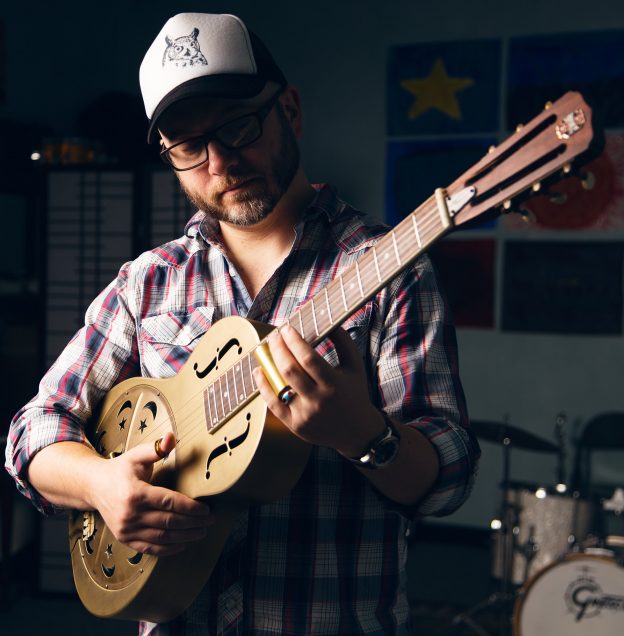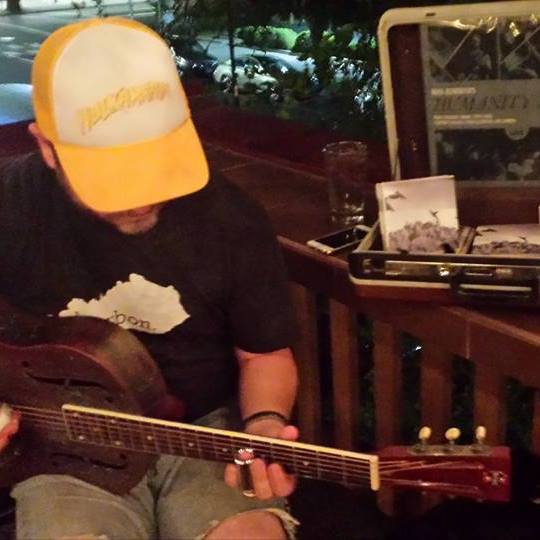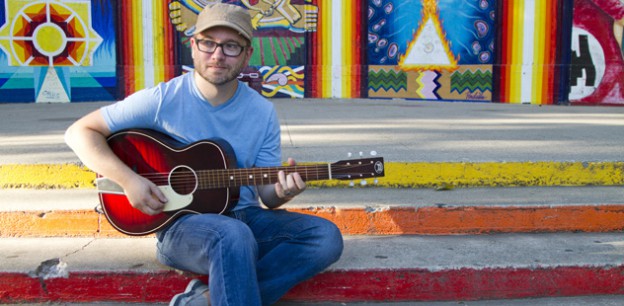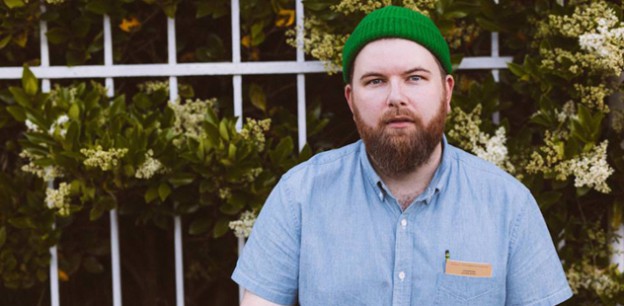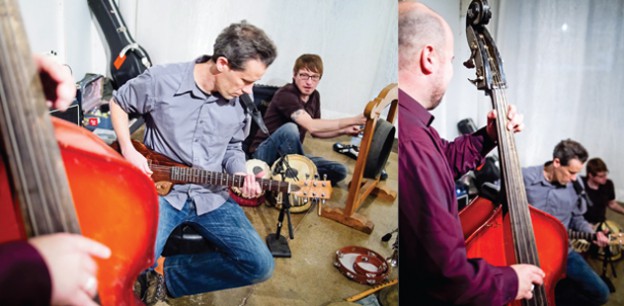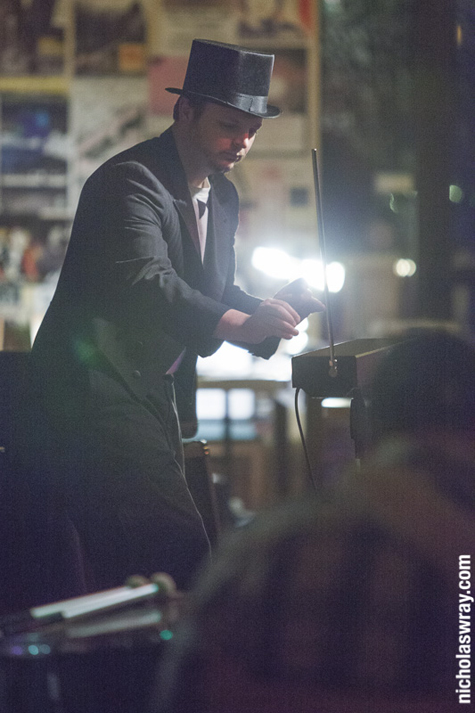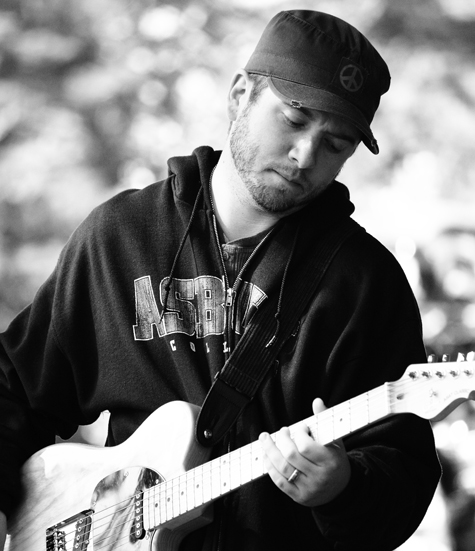On Friday, Sept. 1, 2017, local guitarist Ross Hammond will play a 12-hour concert at Luna’s Cafe as an effort to raise money for the Sacramento Food Bank & Family Services. In what has got to be one of the most charitable and selfless acts by a local musician in some time, Hamond has a set a lofty goal of raising $2,500 for the Sac Food Bank, an important local asset that provides not only food to those in need, but also clothing, refugee assistance, parent and youth education, immigration legal services and much more. Hammond already has an online donation page set up on Generosity.com where you can (and should) donate now, if you have the means (click HERE to donate). As of press time for issue #246 he had raised $560, which isn’t bad, but he’s got a ways to go, and that’s where you come in (editor’s update: as of Wednesday, Aug. 30, Hammond had raised just over $2,000!). He’ll also have a tip jar out at Luna’s on Sept. 1 at the marathon concert, which will take place from 9 a.m. to 9 p.m. Hammond will be joined on stage sporadically throughout the day by fellow local musicians. If you can’t make it, the entire concert will also be live streamed on Facebook, Twitter and Periscope. For more info on Ross, visit Rosshammond.com.
**This write-up first appeared in print on page 8 of issue #246 (Aug. 14 – 28, 2017)**
Playing slide guitar is difficult. Even seasoned guitarists will tell you that. So whether you play blues, folk, rock or anything in between, and whether you’re a newbie or a veteran, join local guitar guru Ross Hammond on Sunday, Oct. 9, 2016 for a slide guitar workshop to hone your skills. Hammond will cover proper tuning, techniques, acoustic versus electric slide playing, slide selection, lap versus bottleneck styles and he’ll even demonstrate by playing several tunes. All ages are welcome and he’s only asking for a $10 donation. You’re encouraged to bring a guitar, acoustic preferred. The workshop goes down at Hammond’s intimate performance space and music school, Gold Lion Arts, located at 2733 Riverside Blvd. in Sacramento. For more information on this workshop or other lessons—they also offer instruction for bass, drums, piano and voice—shoot an email to goldlionarts@gmail.com.
Catching Up with Ross Hammond as He Readies the Release of His New Album, Flight
Ross Hammond stuck out like a guitar player’s sore strumming thumb sitting in front of the Old Soul coffeehouse at the Weatherstone. Wearing one of his signature golf caps and sleek black eyeglasses, with a guitar case resting up against the brick wall behind him, he was unmistakable even from a distance.
With each step I took toward him, though, the more I surveyed the scene for a blonde little girl wandering about somewhere nearby—his daughter Lola, I’ve heard, isn’t usually too far from his side. Apparently, I had just missed her. Darn it.
And with that, Hammond and I stood up and took a stroll around the blocks of 21st and I streets, spiraling outward in concentric circles as we discussed his latest solo acoustic album, Flight, his recent departure from the annual Midtown In the Flow concert series and how his family continues to be a constant source of inspiration in his music.
Since completing his collaborative quartet album Adored in 2012, Hammond recorded three other joint projects prior to Flight—due out April 14—all of which are about as free jazz and experimental as anything he’s ever done. Flight, however, is much more in the same vein as his eighth-posted album from his Bandcamp page, Music from “Cemetery Rose,” where he also used six- and 12-string guitars to evoke more of a rural, outdoorsy sentiment through traditional country-like twang and discernible folk melodies.
Much like “Cemetery Rose,” Hammond says he wanted to take Flight back to the basics of acoustic, which his teacher Jimi Butler once described to him as the bedrock of all guitar playing.
“He told me a long time ago. He said, ‘Hey man, if you can’t play on acoustic, you can’t play shit,’” Hammond says with a smirk on his face. “So, you know. I mean, I agree with that. But I’ve been wanting to do an acoustic thing for a long time now.”
Still, Hammond’s newest record truly feels like it belongs in a league of its own, if not for its rejuvenating spiritual aesthetic—where each track unpacks like a bindle with a sense of reflection and, at times, even adventure—then just for the unfiltered homegrown recipe of a man, his guitars and a portable Zoom recorder. That’s all Flight is. Nothing more, nothing less.
“It’s like, ‘How bare bones can I get? How minimalist can I get? And will it work if it’s just one instrument with no overdubs, no real processing?’” Hammond says. “I want it to sound raw like it sounds at the kitchen table.”
A recurring theme in almost all of his works, it comes as no surprise that Hammond’s family life seeps its way onto the record in some of the most endearing ways. In “When Cows Face the Same Direction,” listeners can actually hear echoes of his daughter Lola playing with her mother in the background while Hammond sits at home and records live around his loved ones.
“I’m a sentimental dude,” he says. “I like that kind of stuff.”
The song “You Are My Sunshine” is also dedicated to his daughter, standing as the only track on the album to receive a music video treatment, which portrays a fragmented day in the life of the Hammonds in super-slow motion.
“For me, the best music you’re gonna make is not because you’ve been sitting at home and practicing your scales all day, or learning all these freakin’ chords and stuff,” Hammond says. “The best music anyone’s going to make is music that resonates and music that is related to how they live. And the message that they’re trying to send, and how to channel their life through sound. To me, that’s the most important thing.”
Between being a family man, running his live music studio (Gold Lion Arts in Land Park) and trying to succeed as a full-time musician who distributes his own records, Hammond has had to let go of some of his former booking duties here in Sacramento—primarily for the In the Flow festival that he’s hosted annually since 2008, which incorporated live local music, local art, spoken word and open mics throughout different venues in Midtown and Downtown.
Hammond says practically all the responsibilities of running In the Flow were being bounced off of him in one way or another, despite having volunteers. At its busiest, In the Flow was juggling about 35 local bands over the course of five days.
“So that was a lot of fun, it was really cool. But for me, it had kind of—it was just getting to be too much work for one person,” Hammond explains. “I just felt like we did it. We said what we wanted to say and it was cool. And now, it’s like I have a space [in Gold Lion] and we can basically do something similar to In the Flow over the whole year.”
In other words, Hammond is just trying to be responsible—both to his family and to himself. Nothing wrong with that at all.
Feeling as though he’s done his fair share for the local jazz and creative music scene in Sacramento, Hammond says he’s at a point now where he wants to pull back a bit and focus more on furthering his own life and career goals, which are not necessarily tied to this town.
“I mean, at this point, I like living here. I like that I can make a living here and stuff. But after so long, I don’t really feel a responsibility,” Hammond says. “And one of these days, you know, one of these days we may just pick up and, ‘Oh, let’s go check out what Chicago’s like. Or let’s see what New York’s like.’”
Hosting the same kinds of shows and cycling through the same sorts of gigs in Sacramento, he adds, tends to create a “revolving door” effect for artists here. It’s a phenomenon he hopes to avoid by following his music down whatever path it may lead him—wherever it leads him—and, of course, taking his family along for the ride the entire way.
“It’s trying to fit everything in,” he says. “I’m trying to be a dad and trying to be a husband and trying to be a guitar player and not suck at any of those things. That’s the trick.”
In the midst of the juggle, Hammond ponders his next move.
“So the next thing? I don’t know. I mean recording-wise and then long term, who knows?” he says. “I’ve got a two-year lease on Gold Lion, and then if we renew our rent might go up like $40. So we’ll see—we’ll just see how it goes. As long as I’ve got the family happening, I’m not tied to anything.”
Ross Hammond’s Flight is available for pre-order via his website, Rosshammond.com. He’ll be celebrating the release of the album with two shows: The first will be a solo show at Gold Lion Arts (2733 Riverside Boulevard, Sacramento) at 4 p.m. on April 12, 2015. On April 13, you can catch him at Luna’s Cafe (with Alex Jenkins on percussion) as part of the Nebraska Mondays series. Go to Lunascafe.com for more info.
From 2006 to 2010, the regional folk/Americana band Silver Darling enchanted fans locally as well as up and down the West Coast via extensive touring, sharing the stage with such greats as Jason Isbell, Damien Jurado, The Cave Singers and others. Silver Darling released one full-length album (Your Ghost Fits My Skin) and an EP (Wrap Around My Heart) via Davis-based indie label Crossbill Records, and they even landed on one of the covers of issue No. 16 of Submerge! When the group ultimately disbanded, frontman Kevin Lee Florence, who now lives in Portland, Oregon, began focusing on his solo career. He has now released his first solo album Given on Fluff and Gravy Records and is preparing for his long-awaited return to Sacramento for an all-ages gig at Insight Coffee Roasters (1901 8th Street, Sacramento) with local guitarist Ross Hammond on Saturday, March 21, 2015. “Flecked with folk influences, finger-picked guitar lines and distinctive harmonies provided by his sister Kelly Florence, Given falls somewhere between Sam Beam’s hushed, vivid folk and [Paul] Simon’s own conversational, quirky lyrical genius,” his bio reads on Kevinleeflorence.com. The album was recorded almost entirely live in the hip and artistic Echo Park area of Los Angeles at Fivestar Studios, where artists like Father John Misty, Bonnie “Prince” Billy and the band Dawes and have also worked. Given features a slew of world-class musicians, including Florence’s personal hero, Garth Hudson of the legendary Canadian-American roots rock group The Band, as well as bassist Jon Button (Sheryl Crow, Robben Ford), drummer James McAlister (Sufjan Stevens, Bill Frisell), and guitarist Danny Donnelly. Hit up Spotify or Florence’s website to hear a stream of Given. We highly suggest taking in the whole thing; but if you’re in a hurry, make sure to at least check out the album’s ethereal opener, “Alone and Everything,” and the single (track 3 on the album) “Peace Like a River,” which has a really cool psychedelic Beatles-esque stomp to it. The March 21 show at Insight kicks off at 7 p.m. and is just $5 at the door.
East-meets-jazz improvisational trio Swimming in Bengal releases new album
Eyes peripherally on each other, ears perked, a trio starts a meditative tune with the strumming of what sounds like a sitar but is actually Jed Brewer’s guitar, specially constructed to mimic the eastern instrument’s twang.
Brewer is accompanied by the methodical drumming of Alex Jenkins’ tabla and either a sharp interruption of saxophone or a deep rumble from a standup bass, both played by Tony Passarell, adding a jazz element to the improvisational piece.
Pieces are a more accurate description than songs for what makes up Swimming in Bengal’s Volume 1 album. Don’t expect to ever hear the three tracks played live. In total improv fashion, the trio plays whatever it feels, when it can, where it can, without notes.
“Sacramento is historically a music/jazz/improv city,” says Jenkins. “We have a deep and rich history of improv that dates back to the 1930s. You can find jazz/improv music every night of the week in Sacramento.”
Chances are, wherever you find that improv, you’ll find Jenkins or Passarell too—and less frequently but just as passionately, Brewer—as all three play in multiple bands, ensembles and jam sessions throughout the city, in churches, cafes, bars, music fests and local art galleries.
Jenkins has been playing drums for more than 25 years and tabla for 12 years. He took two long music study trips to India and attended the Ali Akbar College of Music in San Rafael, California, for five years.
He now teaches “everything drums” and has been a full-time musician since 2003 (often with Passarell) in The Alex Jenkins Trio, The Nada Brahma Music Ensemble, Ross Hammond, Inertia, The Alex Jenkins Sound Immersion and other bands, almost all part of the improv scene.
In 2005, he won a Sacramento Music Award for his work on the self-titled Daisy Spot record release, and another in 2008 for his work with the Ross Hammond Trio.
“It’s better than 90 percent of the crap out there,” Jenkins says about why he loves and plays improvisational music.
For Passarell, the love comes from his musical interests and influences. These include Carnatic jazz, a fusion of Indian Carnatic music with American jazz that both utilize improv; jazz pianist Vijay Iyer; and Steve Coleman and his concept of M-Base, an idea of creating music that relies on improv and has “a very angular and snake charm-y” sound, according to Passarell.
He named several musicians across the country who have mashed eastern sounds with modern jazz, so that’s what Passarell was hoping to do when he first came across Brewer.
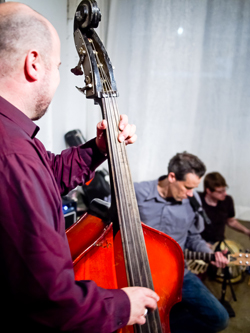
“A few years ago, my wife was teaching at a school and Jed was teaching at the same school (he teaches second grade) and we had a ton of mutual musician friends but had never met somehow,” Passarell says. “He said he had gotten this special gourd/sitar/guitar and I had heard his band San Kazakgascar that has a similar sound I was looking for. I knew Alex Jenkins for years so I introduced those guys and it was just one of those things where we got in a room and started playing together and it sounded good.”
Out of this initial session came Swimming in Bengal, for now an experimental collaboration with no specific musical direction.
“All bands are whatever the musicians bring to them stylistically,” Passarell says. “Because Alex and I are full-blown improvisers, we start at zero and end at zero. You’re using whatever chops you have and whatever you can bring to the table to hook people. It’s already a huge part of Indian music, like Ravi Shankar. He was often improvising.”
Passarell has been part of the music scene since the early ‘70s, starting with jazz but moving into early punk in the Bay Area and Northern California where he grew up.
“My first band that people actually liked was Hunting Game. We used to tour around, had a record, got some airplay, so I kind of got away from jazz in the ‘80s and then went back in late ‘80s. I never stopped listening to it, though.”
Brewer, meanwhile, grew up playing guitar and has been part of several bands in Sacramento since the early ‘90s, even starting a co-op record label, Lather Records, to release his and friends’ music. It’s a low-profile operation, he says, with no recording studio and bands paying for their releases; but with faster and easier ways of sharing music online, the bands have grown their local following easily through the small label.
Brewer’s band San Kazakgascar also has a quasi-Middle Eastern and Indian-inspired sound, something that appealed to Passarell. The differences for Brewer, however, took some time to get used to—where San Kazakgascar is loud, lyrical and structured, Swimming in Bengal is not any of those things.
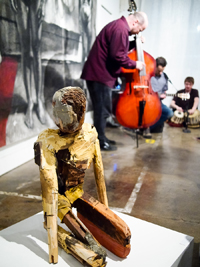
“It was challenging for me at first, but I’m getting more used to it,” he says of improvising. “We’re not doing anything authentic, just approximating those sounds and doing our take on it. [Jenkins and Passarell] come from a jazz background and I come from a more underground rock background. Sometimes we’ll do a show and I won’t have seen Alex for months and we’ll meet up and say hi and we’ll just start playing.”
Swimming in Bengal’s upcoming appearance is at the Davis Music Festival, a place dear to Brewer, as a UC Davis alum and former employee at the Davis-based community radio station KDVS.
“When I was a teenager, I really liked thrash metal so I wanted to play that and then I started finding out about other music when I went to school at Davis and worked at the radio station,” he says. “Even years after I worked there, a lot of great DJs have turned me on to music that influences what I play now. They really opened up my eyes to the weirdo music that’s out there compared to all commercial stuff.”
His favorite bands and influences include Sonic Youth, Metallica, Camper van Beethoven and Thinking Fellers Union Local 282.
As for Indian music, Brewer never grew up listening to it, but it’s always affected him.
“It’s minor sounding, and I like the chromatic nature of it too,” he says. “Something about the scales and melodies has always really attracted me. There are rock bands that have a little of that in it.”
The trance-like droning music that comes out of Brewer’s guitar suits the style perfectly, though not everyone may have an ear for it.
“We are pretty straight with the shows—sometimes we’re sitting, sometimes we’re standing,” he says. “You have to really like the music. It’s not really a show-show. You won’t see us jumping around. People with ears more geared toward instrumental like it, so it’s a small group but enthusiastic.”
Passarell separately adds that an audience hasn’t really been built for what Swimming in Bengal plays, but events like the Davis Jazz Festival have been embracing of their style.
“A lot of it is just exposing people to stuff and seeing how they react to it,” he says, adding that this is much easier to do than it was 30 years ago. “That’s a big difference between the ‘70s, ‘80s and now, being able to produce and promote your own stuff, it’s a totally different world. You could barely afford to do anything back then. It was a lot of money. That stuff’s coming around, for bad musicians and good ones. It’s kind of great though because people can decide if your stuff is good or bad.”
With the current Swimming in Bengal album out with Lather Records, and another on the way in a few months, listeners can decide for themselves whether the improvisational East meets jazz sound is right for them. Check out Sanskazakgascarsolo.bandcamp.com to order the CD or download the album. You can see the band live as part of the Davis Music Festival on June 22, 2014. The festival will feature 54 bands playing in 11 venues from June 20–22. For more info, go to Facebook.com/davismusicfest.
Instagon
Marilyn’s on K, Sacramento – Saturday, Feb. 2, 2013
No two shows are ever the same, and the band has been around the Sacramento and Southern California areas as long as Lob’s ponytail. Lob being the only consistent bass player and founding member of the amoeba that is the band Instagon.
Instagon is a free-form, experimental jam band that has performed more than 600 shows to date and has logged an equal amount of intentionally rotating band members. So, how does that work, exactly? Lob extends invitations to a wide variety of local talents, like guitarist Ross Hammond or Leticia Garcia of Ghostplay to join in; he’s even included Greg Ginn of Black Flag and Rikk Agnew from The Adolescents and D.I. during past performances. However, this past weekend at Marilyn’s on K, Instagon celebrated its 20th anniversary with a one-of-a-kind live show including more than a dozen musicians featuring eight guitarists, a drum circle at the foot of the stage, two drums sets, lots of brass and the list continues.
“When [Instagon] first started it was kind of like, let’s invite everybody out to make noise at once. Then, it kind of evolved into more of a band like it is now and it’s gone through many phases,” explains Lob. “In the early days, I would show up with a hand drill. We even did a show once where it was the Instagon Tool and Appliance Orchestra where there was even a blender section.”
Lob describes Instagon in many words, but two will do just fine—noise art. And it was certainly noisy at Marilyn’s this past weekend with audience members staring at the cluster of musicians before them.
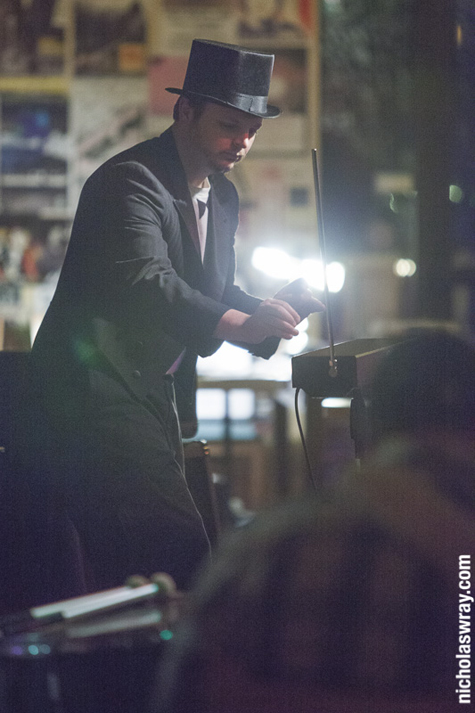
Just before Instagon’s performance, Lob calls all participants outside for a few quick pointers, and there are only two guidelines to his improv orchestra, if he brings the tone low, go ahead and feel free to introduce a solo or take the music in a different direction. But, if the tone of his bass is louder or higher, then that’s the signal to just jam along with the rest of the band. After a bit of reefer is passed around and all was said and done, the 20-year rendition of Instagon shuffles one-by-one back inside the venue, some extinguishing their last cigarette before finding a spot on stage.
“It’s really an escape for me. I’m going to invoke this demon and ride it. It’s really like a voodoo ritual,” says Lob. “I’m going to feel the energy and the power from it. I really enjoy the energy of what Instagon brings to the stage and anybody that’s played will attest to that. To be a part of that is amazing and fun.”
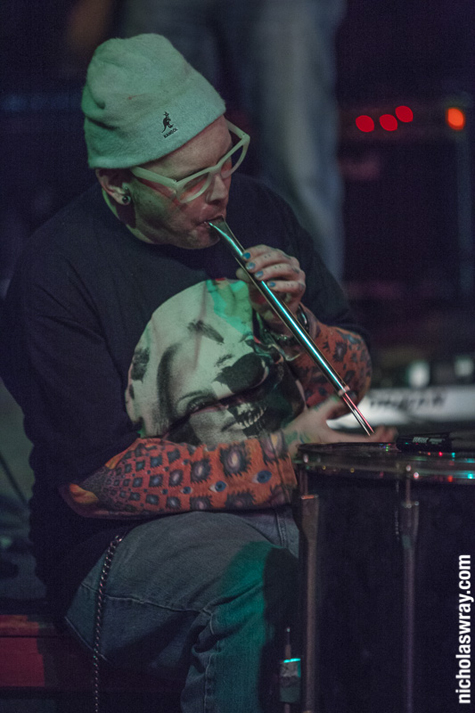
Wails and screams emit from Instagon’s unique, 20-year anniversary performance courtesy of one short-haired woman. A masked man very reminiscent of Hannibal Lecter sits at the foot of the stage aggressively slapping his conga-looking drum, another woman fiddles with her Theremin radiating off-kilter, sci-fi notes while another man dressed in a black top hat and long fancy coat (like something Luciano Pavarotti might wear) gets weird on another Theremin. Then, there’s the saxophonist, who continually wails into a microphone. And then, there are the two drummers, jamming alongside one another toward the back. Plus, the single trumpet player from the band Egg of Winters is dancing about. Oh, and the eight guitarists. Not to mention countless extra musicians hidden behind one another on the crowded stage. In the end, the list of musical instruments goes on longer than “The Twelve Days of Christmas” song and all band members are contributing just about every note scaling the entire alphabet. It’s chaotic. It’s a bit Sun Ra. It’s a bit tribal. And at the center of it all is Lob, a conductor of noise art and his baton, a bass guitar.

Former guitarist of indie rock band Der Spazm and founding member of her newest project Ghostplay, Leticia Garcia, has performed in a couple versions of Instagon and says the music helped her the most at a time when she stepped away from music. She says the improvisational style kept her on her toes and often introduced her to new musicians.
“I really had no idea what to expect,” admits Garcia. “It was challenging and forced me to play a different style of guitar than I was used to. I was also surrounded by other very talented musicians including members of Musical Charis, ZuhG and the Trees. It ended up being a real rush because it was all improv. There was no way to tell what bass riff Lob was going to throw down and how the other musicians would react.”
And it was just that, which kept Garcia accepting Lob’s invites when Instagon scheduled another performance around town.
“You just never know what is going to happen. Sometimes, the music will be so-so, but then all of a sudden you have a moment of ‘Whoa! That was amazing!’” says Garcia. “That’s what [it’s] about, those little moments of amazing, those musical moments that will never ever happen again. It becomes something special for everyone there watching the show and the musicians playing.”
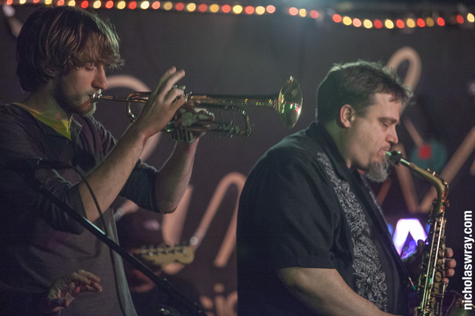
With more than 600 different combinations of musicians and more than 600 shows logged on Instagon’s website, which is like an intricately kept Internet database, one can read all the names Lob’s invited to play alongside him. He’s even attached dates to each name and whether or not the musician performed a second or third time. Yeah, it’s all there.
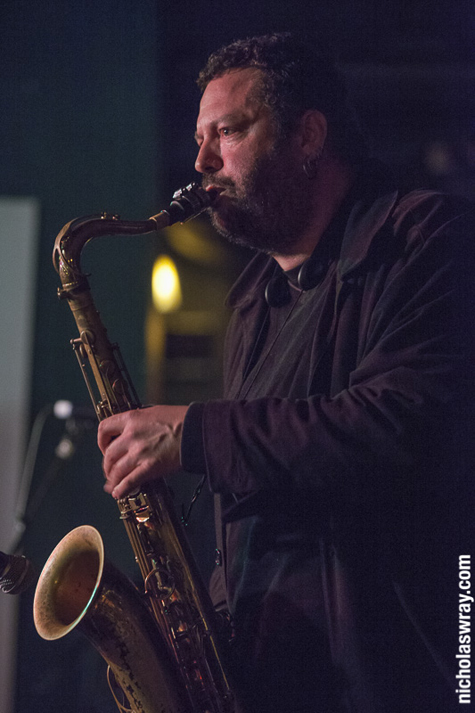
“I’ll see a player who’s really fluid and I’ll go, ‘Oh, I gotta invite him to [Instagon]’ because he’s gonna get it,” says Lob. “Sometimes, people are standoff-ish because they don’t want to join [another band]. I don’t want you to join my band. I just want you to come experience this on stage jam thing. Instagon’s the mistress band.”
Finally, a band you can cheat on your band with.

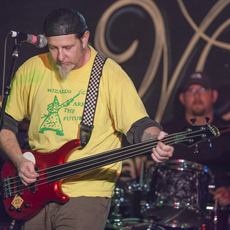
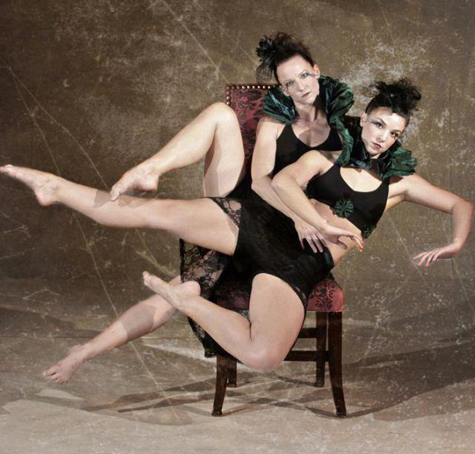
CORE Dance Collective
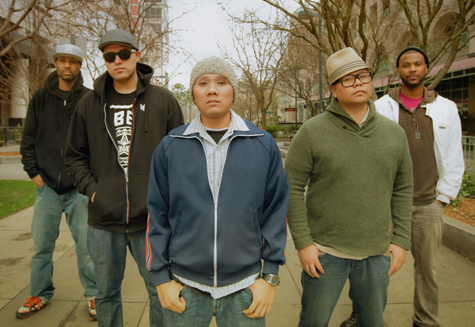
Live Manikins
For the second year in a row, October will be transformed into ARTober, and on Oct. 20 the Midtown Arts Festival will feature all kinds of performers and artists. The festivities will take place outside of the MARRS Building (1050 20th Street) from noon to 6 p.m. The SMUD Performing Arts Stage will host dance groups like Jodette’s Belly Dance Academy, Step 1 Dance and Fitness and the Submerge Band Stage will host The Royal Jelly, Sicfus, Ross Hammond and others. An array of booths featuring local artists and crafts will be open for browsing and shopping. There will also be a kid’s arts area and lots of interactive art activities for guests of all ages. Visit the craft beer area, Untapped, featuring many of Sacramento’s diverse breweries and maybe you’ll discover your new favorite beer! The festival expects an estimated count of 3,000 attendees this year, making it a guaranteed party. This event is free so grab all your friends and relish in the beauty of Sacramento’s mild October weather while enjoying the creative talent our city has to offer. Visit the event website for more information on all the fun activities that will be taking place, http://www.exploremidtown.org/MidtownArtsFestival.
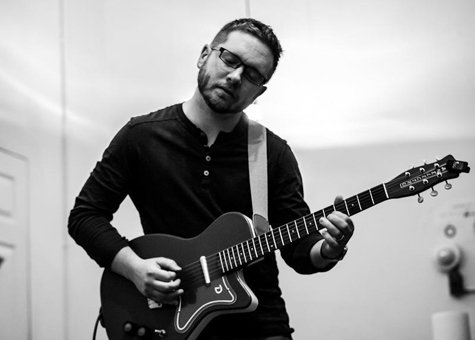
Ross Hammond
“Five years! Wow. I can’t believe it,” says Ross Hammond, local guitar player and primary organizer of In the Flow Festival, which celebrates its fifth birthday from May 9—14, 2012 at various venues around town. “It’s really a good feeling that we’ve managed to get this far,” he said of the improvisational music and art festival that features everything from jazz to rock, poetry and spoken word to electronic music and blues. For Hammond and the others involved, In the Flow is a very personal thing. “We’ve lost some great friends along the way, namely Byron Blackburn and Tommy VanWormer, both of whom helped plan the festival in the early years. So it really is a good feeling because it’s a nice way to keep paying tribute to friends.” Hammond admits that back in 2008, the festival’s formative year, they had no clue what they were doing. They had no permits, no real contracts with talent and a lack of publicity. “But it turned out great,” Hammond remembers. The second year saw them trying to “involve the community more” to really up the ante. They also started incorporating poetry and art. “Every year we’ve grown and it seems like we’ve found a groove,” he said. “Five years feels like we’re legit now.” To view In the Flow Festival’s entire schedule, visit http://intheflowsacramento.com.
WEB EXCLUSIVE!!! EXTENSION OF OUR Q&A WITH ROSS HAMMOND!!!
Submerge is sponsoring an In the Flow Festival show on Friday, May 11 at Phono Select that will feature Afternoon Teacup Collection, Jaroba and Keith Cary as well as Kevin Corcoran. What can you tell our readers about those performers?
Ross Hammond: Kevin is intense. He’s intense and super focused on the sounds he wants to make. There is really no jive with him. He has a great musical intuition and a unique voice on percussion. I really enjoy listening to him (and playing with him too). Afternoon Teacup Collection is our foray into including more classical-based music this year. They are a very cool group of extremely talented musicians playing new classical music. I first saw them at Bows and Arrows last fall and was blown away by them. They did an adaptation of a Terry Riley piece that was completely surreal to see live (in a cafe, nonetheless). Jaroba and Keith Cary are going to be playing a collection of homemade instruments and musical inventions. The first time I saw them Keith was playing a stationary bicycle, which he was using to generate electricity, and using it as an pitch bending oscillator/noisemaker. He ran that signal through one of his amps. While he was doing that, Jaroba was playing a mountain of tubing going into an air horn. Yeah, that’s what they do. They’re pretty badass.
What is In the Flow Festival really all about, anyways? What would you like people to know about it?
RH: In general, In the Flow is about showcasing Sacramento’s creative music, art and poetry (oftentimes marrying all of those together). The programming this year has something that nearly everyone will get into. There is straight-ahead jazz, soul, electronic music, free jazz, noise, rock, hip hop, urban poetry, spoken word, acoustic music and more. I’ve always wanted to collaborate with as many musicians as I can, and this festival has a similar vision. If it’s good, it’s good. That’s pretty much it. That being said, also go see Nagual!
Ross Hammond discusses his new album with The Ross Hammond Quartet and His New Muse
Interviewing Ross Hammond on a Friday afternoon while his wife was out of town meant a secondary task of taking his 18-month old daughter, Lola, for a stroll around the 17th and L block of Midtown.
Lola led the way, while Hammond and I discussed his upcoming Ross Hammond Quartet record due this month. As we strolled and pointed out flowers, dogs and trucks (Lola loves trucks and buses), it became apparent the little blondie was responsible for changes and inspiration in her father she’ll not understand for years. The record, Adored, and Hammond’s artistic growth displayed on the album would not be possible without her.
Our walk began in the alley outside Old Soul Coffee. We did roughly three laps of the block and if we stopped the question was posed, “Lola walk?” In answering, Lola formed her first contribution to the interview tape “Lola walk.” Many of Hammond’s responses were fractured with quick “stay close” requests, but we eventually got down to brass tacks. The immediate information to hash out: Who are the players in the Ross Hammond Quartet?
The ensemble came together mostly through the intricate web of the jazz scene involving booking, travel and of course, collaboration, although Hammond first came to know each member from owning their albums. Whether on stage or in the studio, he said he had several surreal moments that left him pondering, “How did I get here?” The Quartet comprises Hammond on guitar, Vinny Golia on saxophone, Steuart Liebig on contrabass guitar and Alex Cline on percussion. Hammond said he’d known Golia from booking him a gig at the Cool Cat Gallery on 24th–back when it existed–and Cline in a similar fashion. Cline is the twin brother of legendary guitarist Nels Cline, who’s currently playing lead guitar in Wilco. “It’s freaky, dude,” Hammond said regarding the Cline brothers. “They’re identical and both really tall.”
As for Liebig, “I don’t know how I met, Steuart… I guess through the scene.”
He played three to four gigs, including the In the Flow Festival in Sacramento last year, with the members, planting the seed for the quartet. After he’d enlisted the three musicians for a studio session in Los Angeles, the makings of an official ensemble came to fruition.
When it came time to name the project, Hammond was surprised by the other members’ suggestion of naming the quartet after him. At 34, Hammond is the youngest member of the group while the rest were born as far back as the ‘40s. It is a humble and impressive gesture coming from three renowned L.A. jazz musicians who have each had ensembles bearing their namesakes.
“For lack of anything better that’s what it is,” Hammond said. “I’ve never had a quartet before. I also feel like I couldn’t replace any of those guys and still call it the same thing.”
Recorded at Newzone Studio and engineered by Wayne Peet, the album was tracked in six hours with only a few songs needing alternate takes. It’s a feat that speaks to the veteran musicianship of Hammond’s quartet. Hammond would play the riff he had in mind for a song and the ensemble would offer a nod or “OK”–no further tutelage required. He said after each track, it was understood that it felt good and they would move on to the next song.
“Playing with these guys it’s just about staying on the wave,” he said. “You don’t have to give them much instruction at all. I think one of the instructions I gave Vinny was, ‘OK, as soon as this song starts you have to come in like an elephant,’ and that’s what he did.”
Adored is carved from a foundation of folk songs with the title track being a lullaby Hammond sings to Lola at bedtime. Hammond said three of the songs are lullabies he sings. After she’d go to sleep he would figure out the notes and write out the lullaby. The writing is at its most encrypted on “Maribel’s Code,” in which the melody is an intervocalic code built from Lola’s initials: LMH.
“Most of the stuff I write has either a dedication or an idea, be it political or romantic,” Hammond said. “I’m never just like, “oh this is a cool riff, I’ll call it…’”
Three years ago when I first interviewed Hammond, he shared a similar sentiment. The inspiration behind the album title An Effective Use of Space came from a saying his wife frequently used. He said it’s one she still uses to this day. Hammond listed his wife as still his deepest muse, but the birth of his daughter is the primary source of inspiration behind Adored.
The immediacy of the recording is palpable, but it’s done in maturity. Hammond said the difficult task in preparing the music was giving the songs a collected feel, but without being united to the point of bleeding the songs together. Adored roars in, spastic and angry, with “Adored” but as “Sesquipedalian” mellows out it introduces the soft lullaby of “She’s My Little Girl.” Consider the album to be much like Hammond’s day-to-day with Lola; awake at 6 a.m. and full of energy, a settling in period, a mid-day walk with small fits of exuberance and crankiness, a lullaby for a nap or the night’s tuck-in. It is all lovingly expressed in the sea changes of Adored.
“Alex [Cline] told me he doesn’t think you mature as a musician until after you’ve been a dad,” Hammond said. “The gist of it was you stop trying to impress people and focus on filtering this feeling you have and this beautiful thing and turn it into a song. Your muse is different. The goofy songs aren’t there anymore. Having a kid forces you to grow up and you grow up in everything. If anything it’s more purposeful now.”
With the particulars of the album discussed and rocks and leaves in our pockets courtesy of the tyke, Hammond asked Lola, “Wanna go swing? Lola swing?” She offered her second sentence of the afternoon; a sharp “Lola swing.” With that, they strapped into a bicycle and road off to the park.
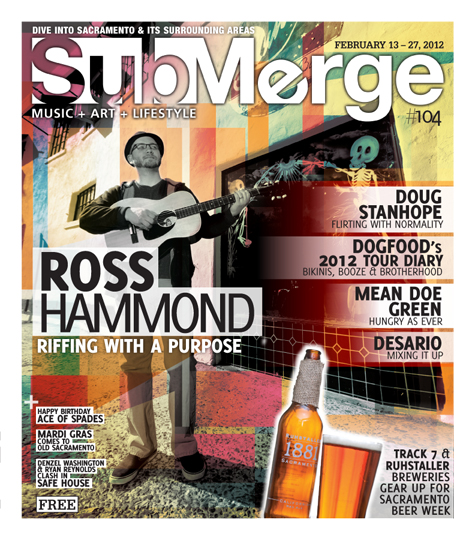
Adored by The Ross Hammond Quartet will be available Feb. 27, 2012. You can preorder it now at Rosshammond.bandcamp.com/album/adored and also listen to the title track. Hammond and co. will throw a CD release party on the very day of its release at Luna’s Café in Sacramento.
Ross Hammond and the Tao of Improvisation
At this year’s SXSW, Ross Hammond, performing with Teakayo Mission, put his rockist touch on the traditional hymn, “Let Us Go Into the House of the Lord,” leading a 14-minute tour of the heavenly kingdom. The live recording sounds as though he and his band mates reached nirvana; but for Hammond, this was just another night of performing in one of his many side projects.
It is tough to say why I feel this way, but the guitar has always been a spiritual instrument in my mind. Perhaps it is images of Jimi Hendrix kneeling in a prayer position, conjuring flames from a burning broken instrument, or the intoxicating feelings that come from Eddie Hazel’s 10-minute guitar soliloquy on Funkadelic’s “Maggot Brain.” A guitar is especially powerful when improvisation is introduced, allowing a guitarist to operate on instinct and inspiration—it is in these delicate moments that musicians seem touched by a divine muse.
Pulling the pomp from these circumstances, such musings can be reduced to just another good night for improvisational jazz—a scene that is garnering some attention in Sacramento. Ross Hammond has been operating within the limitless art form for over a decade, dividing time between improvisational groups, working as a sideman for singers and songwriters, teaching private lessons and curating local jazz shows. Some of his current projects, whether as a leader or session player, include RACE!!!, Teakayo Mission, V-Neck, Lovely Builders and Joaquin’s Night Train. Even with such a prolific resume, he’s reluctant to be dubbed torchbearer for the scene. “A lot of these projects that I’m playing in aren’t mine,” Hammond said. “There’s a lot of passing the leader title around in different projects. Usually a new project is from meeting someone new that’s into a similar idea or finding a new concept about how to present your music.”
Even in the most possessed thralls of improvisation, an artist cannot reach this higher ground without an intense dedication to the craft and community—one monk can’t run a monastery. Hammond views his eagerness to continually invite new musicians into his circle part of this ideal. “Playing with all kinds of different musicians and styles keeps you sharp,” he said. “That’s really the whole idea, in being able to play as much as I can in as many styles as I can.”
Hammond’s predilection for an unabashed marriage of style and technique are the principles for his latest solo record, An Effective Use of Space, a title penned by his wife. “It’s a phrase [she] likes to use when we talk about how things should be arranged in our house,” he said. “I’m sure someone could make a good musical meaning for it too. But it was more of a title that was given after the fact.”
Essentially, his wife has unwittingly helped this writer do just that, as his album suggests jazz feng shui. In a traditional sense, feng shui is an ancient Chinese system of aesthetics for improving ones life through placements of positive energy, but Hammond’s feng shui comes from his guitar-plucking intuition. The record also features several stylistic choices that require delicate placement.
[audio:Heaven Was Getting Crowded.mp3]
Hammond occasionally deviates from his signature sound to pose dedications to friends and family. One of his favorite songs is “Heaven Was Getting Crowded,” which features his recently departed grandmother—Hammond recorded her delivering this joke during her final stay in the hospital. “I wanted to get a recording of her telling her favorite joke, so that’s pretty much how it came out,” he said. “She was a very loving and supportive lady, and she loved to make people laugh. She would tell us and the doctors and medical staff jokes up to her final days.” Without overshadowing the recording, he supports his grandmother’s joke with a bittersweet mood created from solo electric and lap steel guitar loops. “The song is meant as a way to remember her jovial side,” he said.
Once again, I recall Hammond’s SXSW recording. It is as though his guitar is in deep meditation, yet there’s an unspoken connection with his band mates. The spiritual is the constant, while the exploration of a deeper understanding is ritually being sought throughout the performance. “I try to communicate whatever I’m feeling in the moment,” Hammond said. “That obviously has some day to day changes, but there are some parts of my personality that are pretty much constant.” Originally from Lexington, Ky. and raised in the church, Hammond’s spirituality is connected to his guitar playing. “I think most improvisers are that way,” he said. “You should be able to get an idea of what a person is feeling by listening to them play. I think that’s what keeps improvised music honest. But there’s also the factor of what your other band mates are doing. So, it is definitely a balance of trying to get across what you feel while still listening to what’s going on around you.”
The practice of meditation in Eastern religions holds relevance to the improvised jazz performer. Obtaining Zen through meditation involves intense mental stamina as a person directs awareness toward breathing or counting until he or she establishes a trance state. Improvised music shares principles with meditation, as the beat is the groundwork for the journey that comes from reacting to your group and the impulses you feel in the moment. “It’s like you are an antenna that is channeling the music from somewhere else,” he said. “When I play, I’m definitely not thinking about scales or keys. There’s an old adage that says if you are thinking when you play, then you’re gonna muck it up.” Once again, Hammond likened it to his personal experience of participating communally in church, “I think that is a very spiritual thing, because in that sense the music is something that is bigger than just me and whoever I’m playing with. It’s definitely greater than the sum of its parts. I think it’s a similar feeling as being in church, or meditating or whatever else people do to escape. When you are improvising it’s a timeless feeling in that it’s hard to tell if the song you just played was five minutes or 45 minutes.”
Hammond stresses that, though time loses its relevance while performing and the transcendental progression is intoxicating, it is important to hold dear to your purpose. For Hammond, creating is far beyond notes on staff paper, matching scales to chords and counting beats. He spoke with restraint, worried he’d sound too “new age-y,” relating that he created “to convey a sense of unity and harmony in the world we live in.”
Finally, I asked Hammond if he thought his style of improv-jazz was less intimidating than most jazz because of its focus on the guitar and crafting soliloquies. He resisted my hypothesis stating, “I don’t see jazz artists like John Coltrane or Pharoah Sanders being that much different than Pete Seeger or Bob Dylan,” he said. “They are all trying to convey a message through their music. That’s the important part. I think at this point jazz just means ‘not pop.’ Just play what you are feeling. That’s where the real music lies.”

